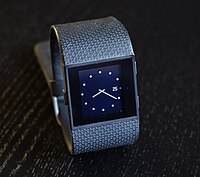
Photo from wikipedia
BACKGROUND Electronic activity monitor systems (EAMSs) have been readily incorporated into physical activity (PA) and weight-loss interventions to facilitate self-monitoring PA behavior. A comprehensive review is required to better understand… Click to show full abstract
BACKGROUND Electronic activity monitor systems (EAMSs) have been readily incorporated into physical activity (PA) and weight-loss interventions to facilitate self-monitoring PA behavior. A comprehensive review is required to better understand their utility as intervention modalities in nonclinical populations. METHODS Medscape, MEDLINE, PsycINFO, and Cochrane databases were searched in February 2017, with a search update in April 2017. Citation screening, risk of bias assessment, and an intensity evaluation were conducted in duplicate by 2 investigators. RESULTS The search returned 409 unique citations. Of which, 22 citations met the inclusion criteria. Seven studies found significant between-group differences: 3 in weight loss, 3 in PA levels, and 1 in both weight loss and PA levels. Effective interventions lasted 6 weeks to 12 months. Positive health outcomes were demonstrated when users interacted with multiple features of the EAMS and had access to other services, such as personal coaching or environmental reinforcement. CONCLUSIONS When control and intervention groups have access to the same components, such as counseling or group interaction, the addition of an EAMS for self-monitoring within the intervention group may not confer more favorable results. Risk of performance bias and low sample sizes should be addressed in future trials to generate more reliable findings.
Journal Title: Journal of physical activity & health
Year Published: 2019
Link to full text (if available)
Share on Social Media: Sign Up to like & get
recommendations!